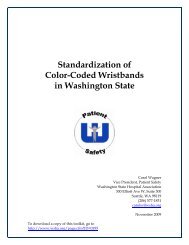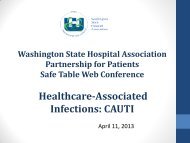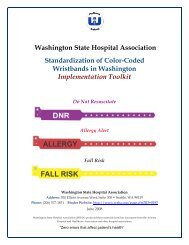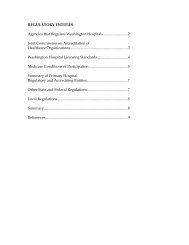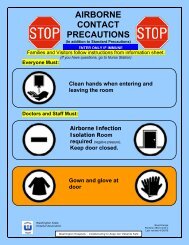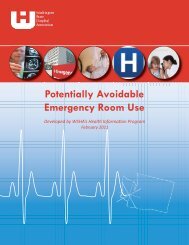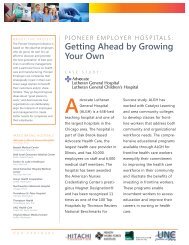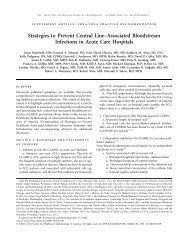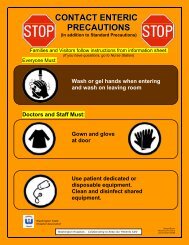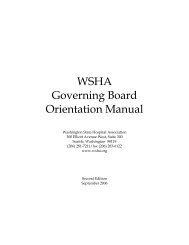Karen Zulkowski Slides - Washington State Hospital Association
Karen Zulkowski Slides - Washington State Hospital Association
Karen Zulkowski Slides - Washington State Hospital Association
- No tags were found...
You also want an ePaper? Increase the reach of your titles
YUMPU automatically turns print PDFs into web optimized ePapers that Google loves.
Prevalence (%)1/30/2013Identify Pressure Ulcers stagesOverview of Pressure Ulcer by stage with focuson Stage II, IV, DTI and unstageableExamine how to accurately assess a woundOverview of Assessment and measurement ofPressure Ulcers and documentationDr. <strong>Karen</strong> <strong>Zulkowski</strong>Montana <strong>State</strong> UniversityIdentify care planning needsPlan and carry out appropriate care based onneedsExamine differences between palliative andcurative care related to treatmentUnderstand Braden scale and any subscaledeficiency relationship to carePlan care based on identified risk and transitionsof care needs Pressure ulcers are costly to treat (more costeffective to prevent)14.0%12.0%10.0% Painful for the patient Aging population has chronic conditions thatimpact the skin and increase pressure ulcer risk8.0%6.0% Level of care and nurse staffing also impactprevention4.0% Throughout all of this is the need to document forcommunication and protection from litigation2.0%0.0%2006 2007 2008 2009 2010 2011 2012Overall Prevalence 13.5% 13.7% 13.5% 12.3% 11.5% 10.8% 9.7%Faciltiy Acquired 6.2% 6.1% 6.0% 5.0% 4.6% 4.3% 3.6%Source: Hill-Rom 2011 IPUP Survey3Medicare estimates that …Excess costs for Pressure Ulcers in Period Prior to Index Date 1Location Error sample Control sample differenceInpatient $40,751 $30,749 $10,271Outpatient $32,949 $25,079 $7,871Pressure Ulcers are ranked #1 as most costlyannual errorsecond only to operative infectionDevelopment of a pressure ulcer adds $47,180to the cost of a hospital stayAndAdults hospital stays that included a PU totaled$11 BILLION in cost (2006)1. Milliman, Society of Actuaries’Health Section. The Economic Measurement of Medical Errors. June 2010 Society ofActuaries p. 18 and 211. Russo, CA, Steiner, C, Spector, W. “<strong>Hospital</strong>izations related to pressure ulcers among adults 18 years and older, 2006. Healthcare Costand Utilization Project. Agency for Healthcare Research and Quality. Rockville MD. December 2008.1
Population1/30/2013Chronic conditions increase with ageOne or more chronicconditionsOne or more chronicconditions, Ages 65+,90.7%Why do older peopledevelop so manypressure ulcers?Two or more chronicconditionsOne or more chronicconditions,Ages 20–44,40.3%One or more chronicconditions, Ages 0–19,27.0%One or more chronicconditions,Ages 45–64,68.0%Two or more chronicconditions, Ages 0–19,6.7%Two or more chronicconditions,Ages 20–44,16.8%Two or more chronicconditions,Ages 45–64,42.8%Two or more chronicconditions, Ages 65+,73.1%Medical Expenditure Panel Survey, 200680,000,00070,000,00060,000,00050,000,00040,000,00030,000,00020,000,00010,000,000072,091,91554,804,47040,228,71234,991,75331,241,8311990 2000 2010 2020 2030Skin changesthat predispose them to be higher risk forskin breakdown and development of woundsAdministration on Age and Aging, Projected Future Growth of the Older Population, available at:http://www.aoa.gov/aoaroot/aging_statistics/future_growth/future_growth.aspxpH increases so is more susceptible to infectionTopical medications aren’t as effectiveInflammatory response as well as allergic andirritant reactions are diminishedRete ridgesThese functional impairments also decrease the skinsability to healFarage, MA. Miller, KW, Malbach, HI (2008) Functional and physiological characteristics of the aging skin, Aging Clinical and Experimental Research 20 (3) 195- 20012Source: National Pressure Ulcer Advisory Panel2
1/30/2013Other skin conditions can also look similarDermatitisTraumaSurgical incisionsInsect bitesSnake/Spider bites2009 Pressure UlcerDefinition“…localized injury to the skin and/or underlying tissueusually over a bony prominence, as a result of pressure,or pressure in combination with shear.”PressurePerpendicular Force• Compresses Tissue• Restricts Blood Flow• Ischemia & Necrosis• Ruptures Cells &Vessels• Tissue deformationNPUAP/EPUAP Pressure Ulcer Prevention and Treatment Guidelines.www.npuap.org/pr2.htmShearLoading of Body WeightForce Parallel to the Skin• Stretches and distorts internal tissue• May cause occlusion of vesselsperpendicular to skin surfaceThis then leads to ischemia & necrosisマットレスBoneMattressSidemoveIschemia Condition induced bystrained energy[kPa]Makoto Takahashi, Yutarow Tamura. 2005 in Japan4
1/30/2013• NPUAP classification system has 6 stages or categoriesStage IStage IIStage IIIStage IVUnstagebleSuspected Deep tissue injury (sDTI)• Staging is based on the type of tissue visualized orpalpated• Do not reverse stage when documenting a healingpressure ulcerQUICK GUIDE FORPartial thickness ulcerPRESSURE ULCER STAGINGStage IIntact skin with nonblanchableredness of aStage IILoss of dermis presenting as alocalized area usually overshallow open ulcer with a redpinkwound bed ora bony prominenceopen/ruptured serum-filledblister.Suspected deep tissue injuryPurple or maroon localized area ofdiscolored intact skin or blood filledblister due to damage of underlyingsoft tissue from pressure and/or shear.UnstageableBase of wound is covered byFull thickness ulcerdead tissueStage IVStage IIIExposed bone, tendon orSubcutaneous fat may bemuscle.visible but bone, tendon, ormuscle are not exposed.• Staging is based on the type of tissue visualized or palpatedCopyright: <strong>Zulkowski</strong> 2012Definition• Intact skin with non-blanchablerednessof a localized area usually over a bonyprominence• Darkly pigmented skin may not havevisible blanching; its color may differfrom the surrounding areaDescription• Area may be more painful, firm, soft,warmer or cooler than adjacenttissue• Stage I may be difficult to detect inpersons with dark skin tonesDefinition• Partial thickness loss of dermispresenting as a shallow open ulcerwith a red/pink wound bed,without slough• May also present as an intact oropen/ruptured serum-filled orsero-sanguineous filled blisterDescription• Presents as a shiny or dry shallowulcer without slough or bruising• This stage should not be used todescribe skin tears, tape burns,incontinence-associated dermatitis,maceration or excoriationSource: National Pressure Ulcer Advisory PanelSource: National Pressure Ulcer Advisory PanelDefinition• Full thickness tissue loss. Subcutaneous fatmay be visible but bone, tendon or muscleare not exposed. Some slough may bepresent.• May include undermining and tunnelingDescription• The depth of a stage III pressure ulcer variesby anatomical locationThe bridge of the nose, ear, occiput andmalleolus do not have “adipose”subcutaneous tissue and stage III ulcers canbe shallowIn contrast, areas of significant adipositycan develop extremely deep stage IIIpressure ulcers• Bone/tendon is not visible or directlypalpableDefinition• Full thickness tissue loss with exposedbone, tendon or muscleSlough or eschar may be present• Often include undermining and tunnelingDescription• The depth of a stage IV pressure ulcervaries by anatomical locationThe bridge of the nose, ear, occiput andmalleolus do not have “adipose”subcutaneous tissue and stage IV ulcerscan be shallow• Stage IV ulcers can extend into muscleand/or supporting structures (eg fascia,tendon or joint capsule) makingosteomyelitis or osteitis likely to occur• Exposed bone/tendon is visible ordirectly palpableSource: National Pressure Ulcer Advisory PanelSource: National Pressure Ulcer Advisory Panel5
1/30/2013Definition• Full thickness tissue loss in which actual depth ofthe ulcer is completely obscured by slough(yellow, tan, gray, green or brown) and/or eschar(tan, brown or black) in the wound bedDescription• Until enough slough and/or eschar is removed toexpose the base of the wound, the true depthcannot be determined but it will be either a StageIII or IV• Stable (dry, adherent, intact without erythema orfluctuance) eschar on the heels serves as “thebody’s natural (biological) cover” and should notbe removedDefinition• Purple or maroon localized area of discolored intactskin or blood-filled blister due to damage ofunderlying soft tissue from pressure and/or shearDescription• The area may be preceded by tissue that is painful,firm, mushy, boggy, warmer or cooler than adjacenttissue• Deep tissue injury may be difficult to detect inindividuals with dark skin tone• Evolution may include a thin blister over dark woundbed. The wound may further evolve and becomecovered by thin eschar.• Evolution may be rapid exposing additional layers oftissue even with treatmentSource: National Pressure Ulcer Advisory PanelSource: National Pressure Ulcer Advisory PanelDifficult to say with certainty as outer skin maybe intactSometimes it really is a bruiseBetter to document exactly what you see thanhave a facility acquired woundDamage is to deeper tissue and when you seepurplish area is too late to preventHeralding sign of Stage III or IVMay be fromFallsLong OR/ER or transportation timesSplintsAccidentsMedical device related pressure ulcers9.1% of all identified pressure ulcers11.9% of facility acquired pressure ulcersMost frequent locationsAnatomic LocationPercentage of device relatedPressure ulcersEars 20%Sacral/coccyx region 17%Heel 12%Buttocks 10%1. VanGilder, C, Amlung S, Harrison, P, Meyer S. (2009). Results of the 2008-2009 International Pressure Ulcer Prevalence Survey and a 3-year, acute care,unit –specific analysis. Ostomy Wound Management. 55(11):39-45.6
1/30/2013Check between the skin folds and thighsRashMacerationInfection (bacteria or candidiasis)BreakdownPressure ulcers may be inunusual locationsEschar – cornified or dried outdead tissueSlough – liquified or wet dead tissueUndermining – bigger areaof tissue destruction thancan be seen(extends under the edge)Tunneling- tracts extendingout from the wound1/30/2013 38HeadUnderminingToeTunneling1/30/2013 39Measure widest width of the pressure ulcerside to side perpendicular (90° angle) to length.Moisten a cotton-tipped applicator with 0.9% sodiumchloride (NaCl) solution or sterile water.Place applicator tip in deepest aspect of thewound and measure distance to the skin level.1© Ayello, 20137
perception1/30/201323© Ayello, 2013© Ayello, 20134© Ayello, 2013Mobility/ActivityorsensoryBed• Turn/Reposition schedule• Pressure redistribution device• PT/OT consult• Use lifting devicesChair• Reposition schedule• Pressure-redistribution cushion• Assessment of chair fit (wheelchair users)• PT/OT consultThe entire team iscriticalin carrying out thecare planFriction and/ShearMoisture• HOB in lowest position possible – unlesscontraindicated by medical condition• Protect /Elevate heels• Prevent skin to skin contact- (use pillows, dressings,skin barriers & sealants products, padding)• Use Positioning devices,- pillows, wedges• Use devices to lift rather than drag patientIncontinence /Moisture• Clean as soon as possible after soiling• Use skin productive products sealants, barriers creams,films etc• Incontinent pads/ briefs• Routine peri care daily• Skin moisturizerNutritionNutrition, fluids and body weight• Weekly weight; monitor for % change• Baseline height• Consults for Dietician and speech therapist fornutrition, chewing and swallowing problems• Labs• Fluids offered as often as possible• Give Food, vitamin/medication supplements as ordered• Feeding assistancewww.hardfordign.orgOtherpatientspecificrisk factorsOther• Develop interventions related to any other identifiedspecific risk factors (i.e. co-morbidities moisturize dry skin8
1/30/2013BUT…..MOST IMPPORTANT YOU HAVE TO ActuallyCARRY OUT THE PLANEveryone on the team should know their roleBeyond the Risk Scalestop looking at the scoreLook at what’s wrong withinsub-categoriesNutritionMoistureMobilityActivitySensory/perceptionFiction/shearA specialty bed won’t help a patient inthe chairSpecialty bed may be a problem if the patient ismobile since up as they can’t get out of thebed aloneOther devices we areusing decreases ability to movePlan care based on needs for thatpatientCheck skin every time you clean orturn the patientSpecial attention to heels- take socks offLook under tubes, look for wrinkles in bedding9
1/30/2013Know equivalents(Beds, dressings etc)DOCUMENTnpuap.orghttp://www.ahrq.gov/research/ltc/pressureulcertoolkit/10
1/30/2013drkarenz@aol.com11



